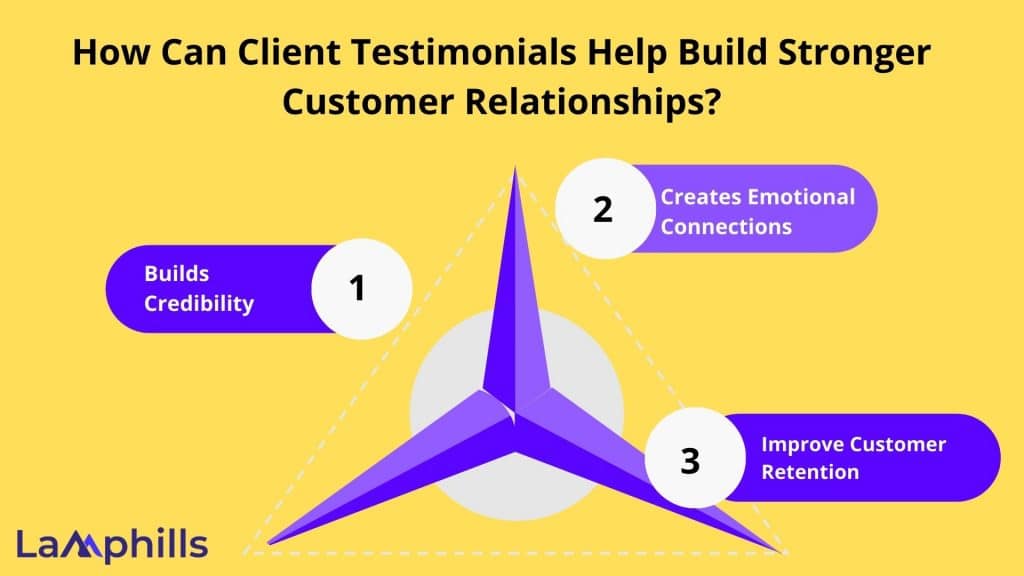Every brand wants to scale up and increase sales. But, how do you stand out and earn the trust of potential customers with the rising competition in every industry? The answer lies in something simple but incredibly powerful: your existing customers’ words otherwise known as client testimonials. Client testimonials foster trust, nurture relationships, and ultimately, grow business. Let’s explore how leveraging client testimonials can strengthen customer relationships and drive your business forward.
Key Points
- Client testimonials are endorsements or statements made by satisfied customers, reflecting their experience with your product or service.
- Client testimonial works because humans are wired to trust the opinions of others, especially people they perceive as peers. In fact, 92% of consumers trust recommendations from people they know, and 70% will trust a recommendation from someone they don’t.
- They are social proof that validates your offerings in the eyes of prospective customers.
- Client testimonials can take various forms such as written testimonials, video testimonials, case studies, and social media reviews.
What Are Client Testimonials?
Client testimonials are endorsements or satisfied customers’ statements, reflecting their experience with your product or service. They serve as a form of social proof, validating your offerings in the eyes of prospective customers. As the well-known marketing strategist Seth Godin put it, “People do not buy goods and services. They buy relations, stories, and magic.” Testimonials tell the story of how your business created magic for someone else—making it easier for others to trust you.
Types of Client Testimonials
There are several types of testimonials; the following are some of them:
- Written testimonials: Simple reviews left on your website or social media platforms.
- Video testimonials: Short clips of customers sharing their success stories.
- Case studies: In-depth analyses of a client’s problem, your solution, and the positive outcome.
- Social media reviews: Casual but powerful endorsements left on platforms like Facebook, Google, or Yelp.
Why Client Testimonials Strengthen Customer Relationships
Humans are wired to trust the opinions of others, especially people they perceive as peers. In fact, 92% of consumers trust recommendations from people they know, and 70% will trust a recommendation from someone they don’t. That’s the power of social proof.
How Can Client Testimonials Help Build Stronger Customer Relationships?

Client testimonials help you build stronger customer relationships in the following ways:
#1. Build Credibility
When a potential client reads or watches a testimonial from a person or business they can relate to, it immediately boosts your credibility.
#2. Create Emotional Connections
Testimonials often describe the journey of a customer overcoming a problem with your help. Prospects reading or hearing these stories will emotionally connect with the outcome.
#3. Improve Customer Retention
Displaying customer stories means you value existing clients’ voices, which reinforces their decision to continue doing business with you. For example, think of a scenario where a satisfied client shares how your customer service helped them navigate a tricky situation. That story can resonate deeply with other customers, instilling trust and loyalty. Trust is a powerful currency in any customer relationship.
Best Ways to Collect Client Testimonials
Gathering authentic testimonials doesn’t have to be complicated. Here’s how to encourage clients to provide glowing feedback:
#1. Encourage Feedback at the Right Time
The best time to ask for a testimonial is right after delivering value. For example, after a successful project, a completed purchase, or a positive interaction with your support team, reach out. A simple email or a post-interaction survey is often enough. For instance, you can send:
“We’d love to hear your thoughts! How did we do?”
“Your feedback means the world to us. Could you take a moment to share your experience?”
#2. Provide an Incentive
Offering a small reward for a testimonial can motivate customers. This doesn’t have to be monetary—a free consultation, a discount on their next purchase, or even a mention on your social media page can be an incentive.
#3. Use Touchpoints Throughout the Customer Journey
Sometimes, the best testimonials come from interactions long after the sale. You can check in with clients to see how they’re doing with your product or service and ask for feedback. The long-term impact of your product can lead to compelling stories.
You can offer clients a template or example they can follow to make the process easier. For example, “Could you describe how our product helped solve your challenge?” “What specific benefits did you experience while using our service?”
How to Use Testimonials for Stronger Customer Relationships
Once you’ve gathered testimonials, how do you deploy them for maximum impact? Check out the steps below:
#1. Display Testimonials on Your Website
Your website is often the first place potential customers visit. Having testimonials prominently displayed can significantly enhance trust. Ensure that testimonials are placed on high-traffic pages such as the home page, product or service pages, and dedicated testimonial pages.
#2. Use Testimonials in Your Marketing Campaigns
Client testimonials are not just for your website. You can repurpose them for email marketing and social media ads
#3. Leverage Video Testimonials
Video is an incredibly powerful medium. People are 84% more likely to buy a product after watching a video. A well-produced video testimonial can establish a strong emotional connection, which is harder to achieve through text alone. Record real customers explaining their journey and how your business helped them reach success.
#4. Integrate Testimonials in Sales Presentations
If your business is service-based, integrating client testimonials into your sales presentations can be handy. It shows potential clients that your solutions have worked for others, which increases your credibility.
How Testimonials Transformed Customer Relationships: My Experience
I once worked with a small digital marketing agency that struggled to retain customers beyond a few months. After a deep dive, we realized we weren’t capitalizing on the positive experiences of our current clients. The agency began actively collecting testimonials, focusing on customer success stories. Within six months, we displayed these testimonials on our landing pages and integrated them into our sales presentations. As a result:
- Customer retention increased by 25%.
- New client acquisition improved by 40%.
Mistakes to Avoid When Using Testimonials
While I encourage brands to leverage client testimonials, you must not overdo it. To make the most of this strategy, kindly avoid the following mistakes:
#1. Faking Testimonials
Don’t be tempted to use fake or overly curated testimonials; it might backfire. The main point of leveraging testimonials is to build trust, and you can’t achieve this with fake content.
#2. Not Updating Testimonials
Outdated testimonials may lead potential customers to question your current service quality. Regularly refresh your testimonials to ensure they stay relevant.
#3. Ignoring Diverse Testimonials
If all your testimonials come from one type of customer, they may not resonate with a wider audience. Show testimonials from different industries, company sizes, or customer types.
#4. Overusing Testimonials
While testimonials are important, overloading pages with too many can dilute their impact. Instead, strategically place a few impactful testimonials where they will be most effective.
How Do I Ask for a Testimonial?
Simply ask! You can do this through follow-up emails after a successful project or post-purchase surveys.
Where Should I Display Client Testimonials?
Strategically place them on your homepage, product pages, and a dedicated testimonial page.
Can I Use Testimonials in Advertising?
Yes, testimonials work exceptionally well in social media ads, email campaigns, and sales presentations.
What Are Some Examples of Templates for Client Testimonials?
Templates are handy when gathering testimonials to provide structure and make it easier for clients to share their feedback. The following are a few client testimonial templates that I have successfully used:
Template 1: Short, Impactful Testimonial
Ideal for quick feedback and social media sharing.
- Client Name: [Your Client’s Name]
- Company: [Client’s Company]
- Testimonial:
“Before working with [Your Business], we struggled with [specific problems]. After partnering with them, we experienced [specific result], and the process was [adjective: seamless, transformative, etc.]. We highly recommend [business name] for anyone looking for [desired outcome].”
Template 2: Story-Based Testimonial
Best for showcasing the journey and transformation a client experienced.
- Client Name: [Your Client’s Name]
- Company: [Client’s Company]
- Testimonial:
“We were facing [describe the problem], and we were unsure how to resolve it. Then, we found [Your Business]. They helped us by [briefly describing the solution]. As a result, we saw [specific outcome: improved sales, greater efficiency, etc.]. We couldn’t be more pleased with the results. [Your business not only helped us solve our problem but they also [added value or additional benefit].”
Template 3: Results-Oriented Testimony
For clients focused on measurable results.
- Client Name: [Your Client’s Name]
- Company: [Client’s Company]
- Testimonial:
“Working with [Your Business] has been a game-changer for us. We saw a [percentage increase] in [key metric] within [timeframe]. Their [product/service] helped us achieve [specific goal]. We highly recommend them to anyone looking to achieve similar results.”
How Long Should a Client Testimonial Be?
In my experience, the length of a client testimonial depends on the platform and purpose, but it should generally be concise and to the point. Client testimonials should be long enough to convey meaningful insights but not so long that they lose the reader’s interest. Aim for 50-150 words for most testimonials, but feel free to go longer if the story is impactful.
Why are Client Testimonials Important for Building Customer Relationships?
Client testimonials serve as powerful social proof. They validate your business by showing that real people have benefited from your products or services. This external validation builds trust because customers naturally rely on the experiences of others before making decisions. By sharing positive testimonials, you reassure potential customers that they’ll receive value, which is the foundation of a strong customer relationship.
I’ve seen clients see relatable testimonials; they are more likely to feel an emotional connection with the brand, which fosters trust and encourages deeper engagement. Strong testimonials also help humanize your business, making it easier for customers to relate to you, which is key to building lasting relationships.
How Can Client Testimonials Improve Trust and Loyalty?
Client testimonials improve trust and loyalty by showcasing real, positive experiences that endorse a brand. When potential customers read or watch testimonials, they identify with those clients’ pain points and see how your business addresses them, increasing confidence in your ability to deliver.
In my work with clients, I’ve found that regularly sharing authentic testimonials helps create transparency, as customers feel they’re receiving an unfiltered view of your services. This leads to higher trust, and trust is the cornerstone of loyalty.
What Are the Best Ways to Collect Client Testimonials?
To collect client testimonials effectively, ask for them at key moments of satisfaction. For instance, after successful project completion, a positive service interaction, or when a client shares unsolicited praise. I’ve found the following to work best:
- Timing: Right after a major success when emotions are high is the perfect time to ask for a testimonial.
- Ease of Process: Make it easy for clients to give you testimonials. Use online forms, emails, or a quick video recording option.
- Provide Prompts: Clients may not know what to say. Give them a simple structure or a few questions to guide their testimonial. For example: “What challenge did you face before working with us?” or “What results did our product help you achieve?”
- Personal Requests: A personalized email or phone call works wonders. When clients know you’re reaching out directly, they’ll likely contribute.
How Do Client Testimonials Impact Brand Credibility?
Testimonials act as endorsements from unbiased third parties, making your brand more trustworthy. It’s one thing to claim your business delivers results; it’s another to have customers back that claim publicly. In my experience, testimonials highlighting measurable results (e.g., “We increased sales by 30% after using their services”) enhance credibility.
How Should I Showcase Client Testimonials on My Website for Maximum Impact?
The placement and format of testimonials can make a huge difference in their effectiveness. Here’s what I recommend based on experience:
- Homepage: Feature standout testimonials on your homepage. Placing them near the top or above the fold ensures they’re seen quickly.
- Dedicated Testimonials Page: Create a page solely for testimonials where you showcase a variety of customer stories in different formats (text, video, case studies).
- Incorporate Visuals: Pair written testimonials with photos or videos of the clients. Visuals add authenticity and make the testimonials more engaging.
- Highlight Specific Services or Products: Place relevant testimonials next to specific product or service descriptions, especially on product pages. This helps convince customers when they are close to making a purchase.
- Rotating Banners: Use rotating testimonial banners in strategic areas like the homepage, sidebar, or checkout page for visibility.
How Do I Incorporate Client Testimonials into My Marketing Strategy?
In my campaigns, I’ve found the following strategies helpful in incorporating client testimonials into my marketing strategy:
- Social Media: I share testimonials on platforms like Instagram, LinkedIn, and Facebook. Short video clips or quote graphics work particularly well here.
- Email Marketing: I include testimonials in my newsletters and email campaigns.
- Landing Pages: For product- or service-specific landing pages, testimonials tailored to those offerings work wonders for conversions.
- Case Studies: I build in-depth case studies from detailed testimonials showing how the product or service helped a client achieve success. These are excellent for B2B marketing and high-ticket products.
- Ads: I incorporate testimonials into paid advertising like Google or Facebook ads. Seeing real customer experiences makes your ads more compelling.
What Types of Client Testimonials are Most Effective for Strengthening Customer Relationships?
In my experience, video, story-based testimonials, influencer testimonials, and detailed testimonials with real metrics create the strongest emotional connection, fostering long-term customer loyalty.
Can Client Testimonials Help in Converting Potential Leads into Loyal Customers?
Absolutely. In the course of my career, I’ve found that testimonials can be the tipping point for conversion, especially when they address specific pain points or objections that prospects have.
How Can Client Testimonials Improve Customer Engagement?
Client testimonials spark engagement by making your brand more relatable and approachable. When current customers share their stories, they humanize your brand, inviting others to join the conversation. In my experience, testimonials shared on social media often generate comments, likes, and shares, as customers love to chime in with their own experiences.
How Do I Turn Positive Testimonials into Long-Term Customer Relationships?
Turning positive testimonials into lasting customer relationships starts with follow-up and appreciation. The following works best from my experience:
- Publicly appreciate customers
- Feature loyal customers
- Incorporate testimonials into loyalty programs.
- Use testimonials to start a conversation.
Lamphills Testimonial Display Checklist
With this Lamphills testimonial checklist, you will be able to leverage client testimonials effectively on your website and other marketing channels.
Download Lamphills Testimonial Display Checklist
Conclusion
Testimonials help tell the story of your business’s success through the eyes of satisfied customers, and leveraging these can dramatically strengthen your customer relationships, create trust, and foster loyalty. So, start gathering your testimonials today and watch as they transform not just your credibility but your customer relationships.
Related Articles
- Transfer Advertising Explained: Boosting Brand Perception Through Strategic Partnerships
- How to Build a Professional Social Media Presence: 12+ Tips
- How to Calculate Social Media Impressions in 2024
- Earned Media Value Explained: Why It Matters and How to Calculate It
- Purpose of Branding: 10 Benefits for Your Business






